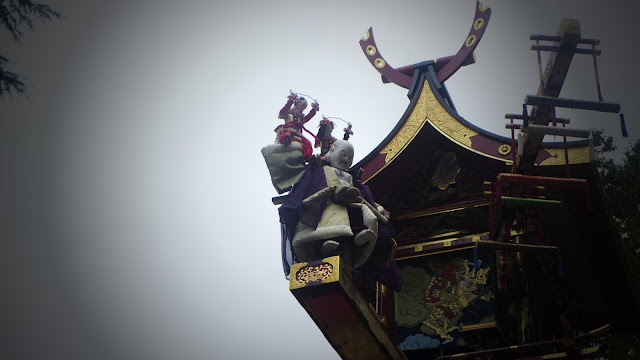Yasuko has just returned from Turin, Italy, where she gave a lecture on Bunraku at the Incanti Puppet Festival. As I watch her sip her cold beer over books on Japanese Kagura and international puppet magazines, it's as though Yasuko is still on the Emperor's trans-pacific mission.
Today, she is a chancellor for UNIMA-Japan, directs an organization, Minerva Group, that hosts cultural events between foreigners and Nagoya residents, and is responsible for assembling the only international tours of karakuri ningyo. Her lifetime of cross-cultural exploration has shaped an insightful, valuable, and global perspective. In conversation, she moves from Edo period parade floats to Poland's experimental theater scene to recalling her time with Swedish theater-maker Michael Meschke.
In 1984, Meschke brought his adaptation of the Ramayana to Japan. The production combined musicians from Thailand, puppeteers from Japan, designers from Europe, and a classic epic from India to create a multicultural tour de force. Meschke's Ramayana illustrated the ability for puppetry to move beyond language, to preserve culture, and to celebrate our collective humanity. It also represented Yasuko Senda's pursuits as a cultural liaison. And in many ways, it was this show that changed Yasuko Senda's trajectory from enthusiast to champion.
Yasuko Senda, then 22, was one of these fortunate citizens. She was selected to visit The United States and spend three months meeting American leaders and fellow young adults. She traveled to dozens of American cities stretching from Los Angeles to New York City. She remembers New Orleans the most vividly, especially because it felt the most exotic and exciting. She recalls this remarkable journey while sitting in her cozy apartment in Imaike, Nagoya, surrounded by books about Italian Opera, Punch and Judy, and Chikamatsu Monzaemon.
 |
|
(Michael Meschke, Yasuko Senda, Elizabeth
and Daddy D. Pudumjee, 2013)
|
While in Japan, Michael Meschke's curiosity led Yasuko Senda down a path that would change her life. The theater director was no stranger to Japanese puppet theater, mounting a Bunraku inspired production of Antigone in 1977. During his 1984 trip to Japan, Meschke's passion for international performance led him to seek out more marginalized forms of traditional Japanese theater. He came to Yasuko Senda for help. With her fiery generosity and passion for cultural exchange, there was no better person to ask. Yasuko recalled a conversation she had with a local TV producer regarding unusual robotic dolls performed at festivals. She decided to investigate further, scouring through the producer's documentary footage. To her amazement, these puppets were still being performed all over Japan. One of the main footholds of the traditions was Aichi Prefecture, her home province. This discovery brought thrills, but also shock and alarm. How had she spent her entire life so close to these mechanical puppets without knowing a thing about them? And why was there such a frightening lack of information about this art form?
The same year Yasuko Senda discovered karakuri ningyo, The Japan Arts Council and Ministry of Education reopened the National Bunraku Theater in Osaka. While Japan's government made a major commitment to sustaining and celebrating Japan's traditional puppet theater, karakuri ningyo was widely overlooked. Similar to the puppet rituals of Awaji island, karakuri ningyo was considered low art and less refined than Bunraku. Yet, as leadership curated its national art forms to include Kabuki, Noh, and Bunraku, Yasuko Senda was impelled to research and document the elusive karakuri ningyo.
For the next six years, Yasuko Senda visited Japanese festivals, compiled research and photographs, and eventually published one of the first books about karakuri ningyo in modern Japan. She also organized the first international tours of karakuri ningyo in 1984, bringing master Tamaya Shobei IX, Chiryu Karakuri Ningyo Theatre, and Hekinan's karakuri ningyo across the globe. Subsequently, she has organized tours to Slovenia (’92), Poland (’98 / ’12), Croatia (’02), Australia (’08), Sweden (’09), and Spain (’16). In 2013, she self-published an English text on karakuri ningyo, contributing to her role in preserving karakuri ningyo for both national and global communities.
Just last month, The United Nation's UNESCO inducted Central Japan's dashi and karakuri ningyo onto the Intangible Cultural Heritage list. It's a remarkable victory for the craft. Today, with growing support and interest, it joins the ranks also inhabited by Japanese Noh, Kabuki, and Bunraku.
When I travel with Yasuko Senda through Japan's matsuri celebrations, I always have trouble keeping up. As I try to follow her swift saunter in and out of the crowds, it's easy to imagine 22 year-old Yasuko fueled by curiosity, criss-crossing the streets of the French Quarter under the spell of a foreign land. Fifty years later, Yasuko Senda's passion and her generosity has cast a spell of her own, turning back history, and preserving a piece of the Japanese spirit.
Yasuko Senda's 2013 English-translated text, Karakuri Ningyo. Japanese Automata, is a fantastic reference for puppet makers, historians, and automata enthusiasts. It includes mechanical drawings, historical background, and descriptions of many karakuri ningyo festivals in Japan. With maps and calendars you won't find online, Karakuri Ningyo. Japanese Automata is also a great reference for travelers seeking festivals off the beaten path.
To order Karakuri Ningyo. Japanese Automata (English / $30 / €28), please contact Ms. Senda directly at: senday@ams.odn.ne.jp
Yasuko Senda's Japanese texts include:
Treasurehouse of Karakuri Ningyo [ 1991 ]
Karakuri Ningyo Maker Shobei Tamaya IX [ 1998 ]
World of Karakuri Ningyo [ 2005 ]
























































